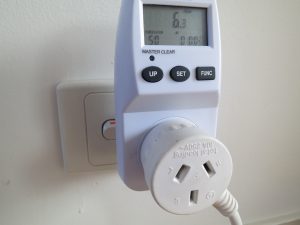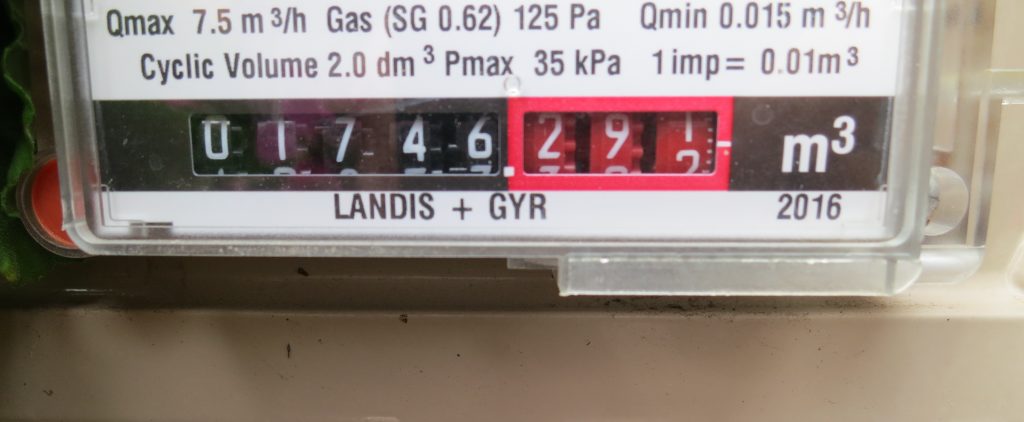Energy monitoring is a great way to track your energy usage and to eliminate unnecessary electricity and gas usage. Here’s three easy ways to track your energy use:
1. Track your total usage using your gas or electricity bill
- Your gas and electricity bill should how many MJ (Megajoules for gas) or kWh (kilowatt hours for electricity) you are using per day and the total amount for the billing period.
- The bill will also show you the cost per MJ or kWh. This is useful for tracking your daily, monthly and yearly energy use.
2. Use a power meter
- There are simple power meters that can be purchased for $12 from a hardware or electronics store. Some councils even rent them out on request.
- A power meter plugs into a power point and has a single power outlet that you can plug a device into.
- If it is designed for an Australian power outlet, it should be rated for 240V/10A (In other words, don’t plug one into a powerboard that has three fan heaters connected to it).
- They display voltage, amps, instant W/kW use and W/kW use over time. You can even put in an electricity kWh rate to see the cost of running an appliance over a time period.
The process is simple, just plug in the power meter into a power point and plug the device that you want to measure into the power meter.
Power meters are the easiest way to measure individual appliances and devices that are plugged into or recharged via a power point.
This is also useful for measuring standby power (power that the device or appliance uses when it is switched off and not in use).

3. Track your total usage using your gas or electricity meter
- To read a gas meter, note down the numbers and decimal point reading from left to right. The reading will be in cubic metres.
- To track your usage over a given time, take a reading from the beginning of that period and then take a reading from the end of that period. Subtract the earlier reading from the later one.
- Learning to read a gas meter is an effective way to measure how much energy your individual gas appliances are using.
- To measure a single appliance, make sure your other gas appliances are switched off for the time your are measuring.
To convert your usage from cubic metres to MJ (Megajoules), multiply the reading by 38. To convert from MJ to kWh (kilowatt hours) for comparisons with your electricity usage, multiply the MJ amount by 0.28.
- For electricity meters, the process is the same except that the reading will be in kWh.
- If you have a smart meter, you can actually see your daily and hourly electricity consumption online if your electricity provider has enabled this feature (ask them if you are not sure).
- Reading an electricity meter is useful for monitoring electrical appliances that are permanently wired to the mains power supply (like air conditioners, heaters, ovens, stoves hot water units and lighting).
- The process is the same, turn off all of your other electrical appliances and run the one appliance that you want to measure for say an hour whilst taking readings at the beginning and the end of that hour.
- Knowing how to read your gas or electricity meter is also useful for double checking your bill if you think your utility provider has overcharged you.

What does MJ and kWh mean?
- A kWh (kilowatt hour) is 1kW or 1000 Watts done over an hour (a measurement of work, similar to horsepower). A heavy truck engine can produce 250kWh over 100 kilometres compared to 0.9kWh for a well fed labourer over a 12 hour work day.
- A MJ (Megajoule) is a unit of energy used to measure gas energy consumption (and coincidently, food energy, for example, a hamburger might have 2000kJ/2MJ of energy ).
Benchmarks
Once you’ve worked out your total average daily energy usage over the year, multiply your daily gas MJ usage (if you have a gas connection) by 0.28 to get a kWh figure and then add the gas and electricity kWh figures together to get a total kWh figure.
Using this total, you can compare your usage to the Australian and state average of where you live:
| Australian average | 33kWh a day |
|---|---|
| New South Wales | 28kWh a day |
| Victoria | 51kWh a day |
| Queensland | 21kWh a day |
| South Australia | 30kWh a day |
| Western Australia | 25kWh a day |
| Tasmania | 49kWh a day |
| Northern Territory | 25kWh a day |
| Australian Capital Territory | 49kWh a day |
- The average household in Australia as of 2016 had 2.6 occupants so keep this in mind when comparing your total energy use.
- Also keep in mind, how often your house was occupied (for example, you might have spent 3 months on holidays which may give you an unrealistically low daily average).
- A heavy user will use at least the same or more as the average of the state they live in.
- If you follow the smart renter home energy tips on this site, you should come in at half the average consumption for the warmer states or even a quarter for the colder states.
- A very smart renter should have no problem using 5-20% of the average for their state.
If you have measured individual appliances and devices, you can also see where most of your energy is being used in the home. Here’s the Australian average:
| Total | 33kWh a day |
|---|---|
| Heating and cooling | 12.3kWh a day or 38% of total |
| Hot water | 7kWh a day or 22% of total |
| Cooking | 1.7kWh a day or 5% of total |
| Appliances | 7.5kWh day or 23% of total |
| Lighting | 2.3kWh a day or 7% of total |
| Standby | 1.7kWh a day or 5% of total |
- Cooking, appliance use, lighting and standby power seem to be consistent across the Australian states and territories
- Hot water and heating energy use, not surprisingly tend to rise enormously in the coolest states.
If you’re not sure where to start, just start measuring a few things, learn to read your bills and you’ll develop an intuitive sense of why your electricity and gas bills cost what they do. Then you can take action to reduce them. As they say, knowledge is power.